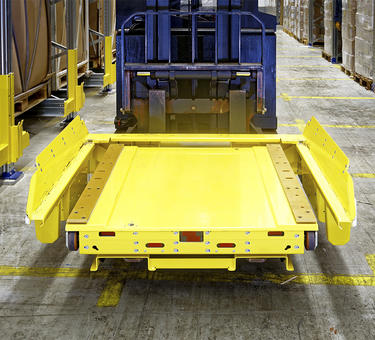
The fork truck is a necessary and important piece of equipment for many warehouse operators.
With costs related to drivers—including training and turn over—contributing to overall fork truck ownership expenses, it is not surprising that automation options are of high interest.
In fact, autonomous or artificial intelligence (AI)-driven fork truck solutions are attracting the attention of warehouse operators looking to control operating costs and offset driver turn over.
Partnering with Customers
In 2020, the Prologis Labs and Prologis Ventures teams partnered with two customers on a set of experiments using automated fork trucks for pallet transport and rack put-away/retrieval.
Unlike pre-programmed fork trucks, automated units “learn” routes, pallet types and configurations; picking and placement patterns; and safety behaviors—in order to optimize truck performance based on customer requirements and the warehouse environment.
The experiments were tailored to meet the requirements of each customer using a variety of test cases, including static and dynamic obstacles, perception at varying distances and angles, dynamic re-routing due to blocked paths, pallet identification and running a continuous four-hour shift. As part of the exercise, Prologis engaged a start-up AI fork truck company to provide a solution to accommodate the features and capabilities requested by each customer.
Areas of Experiment Focus
Working closely with each customer and the AI fork truck provider, Prologis Labs identified key requirements for the creation of experiment scenarios that would closely resemble the workloads and operating parameters used in a fully functioning warehouse.
The scenarios included:
- Pallet Load Type and Configuration: Identification of specific load types, configuration, pallet types and sizes, load height and weight, and load materials to suit various use cases.
- Pallet Identification: How well the vehicle was able to automatically identify a pallet and autonomously orient the vehicle to the correct side of the pallet for pick-up.
- Vehicle Safety: Compliance with ANSI safety standards, how safely the vehicle operated in fully autonomous mode to avoid collisions, operate near people and other equipment/vehicles, ability to govern speed, and safe load transportation including loading and unloading.
- Vehicle Navigation & Routing: How well the vehicle navigated rack aisles, bulk floor aisles, obstacles, nearby equipment/vehicle traffic, ability to self-select an optimal travel path, ability to re-route when a path is blocked.
- Material Handling: How well the vehicle could pick and place pallets from various rack configuration depths (single select, double deep, push-back), how well the vehicle could pick and place pallets from various heights (floor level, above 6’, above 12’), ability to pick and place pallets from non-racked areas.
- Work Rate: How well the vehicle was able to continuously pick and place pallets to reach a defined work-rate or speed to accomplish a defined number of picks and placements in a defined period.
Experiment Results
The results of the experiments demonstrated that AI fork trucks are a viable solution for the automation of warehouse picking and placement operations.
Both customers were very pleased with the results and appreciated the opportunity to test in the Labs’ simulated warehouse environment as experimentation in their production environments was not an option.
As a follow on to the Lab experiments, both customers plan further testing of the AI fork truck solution in their respective production warehouses and are considering broader implementation pending production testing and general product availability.
Key Findings
- Autonomous AI fork trucks provide an effective solution for automated picking and placement of various pallet configurations, load types and picking/placement heights.
- Although autonomous fork trucks operate “on their own”, a remote operator is required to handle situations where a truck requires manual intervention to teach the fork truck how to navigate in the future.
- Autonomous AI fork truck solutions offer the ability for a single, remote operator to control multiple autonomous vehicles from a central location with fork truck to operator ratios as high as 10:1.
- Safety is an important factor when considering the use of any autonomous vehicle. The experiments demonstrated that the AI fork truck solution provides a very safe and dependable set of safety controls to prevent injuries to people as well as damages to racking and other equipment caused by collision.
- For safety reasons, speed of operation of autonomous trucks will tend to be slower than the speeds achieved by human-operated fork trucks. Prologis expects speeds to increase over time as autonomous product safety features mature.
- Many autonomous vehicles and robotics platforms require WiFi network services for guidance and communication systems. Congested WiFi networks can impact the performance and operation of autonomous platforms, particularly when multiple autonomous platforms are in operation simultaneously. Prologis is evaluating other wireless technologies to find alternative solutions to address network congestion concerns.
- Considering the recent impacts to business operations due to COVID-19, autonomous fork trucks enable warehouse operators to function at full capacity in a safe and socially distant manner.
As autonomous fork trucks become more widely available, Prologis expects to see greater adoption as they offer new ways of reducing costs and increasing operating efficiency in warehouse environments.


